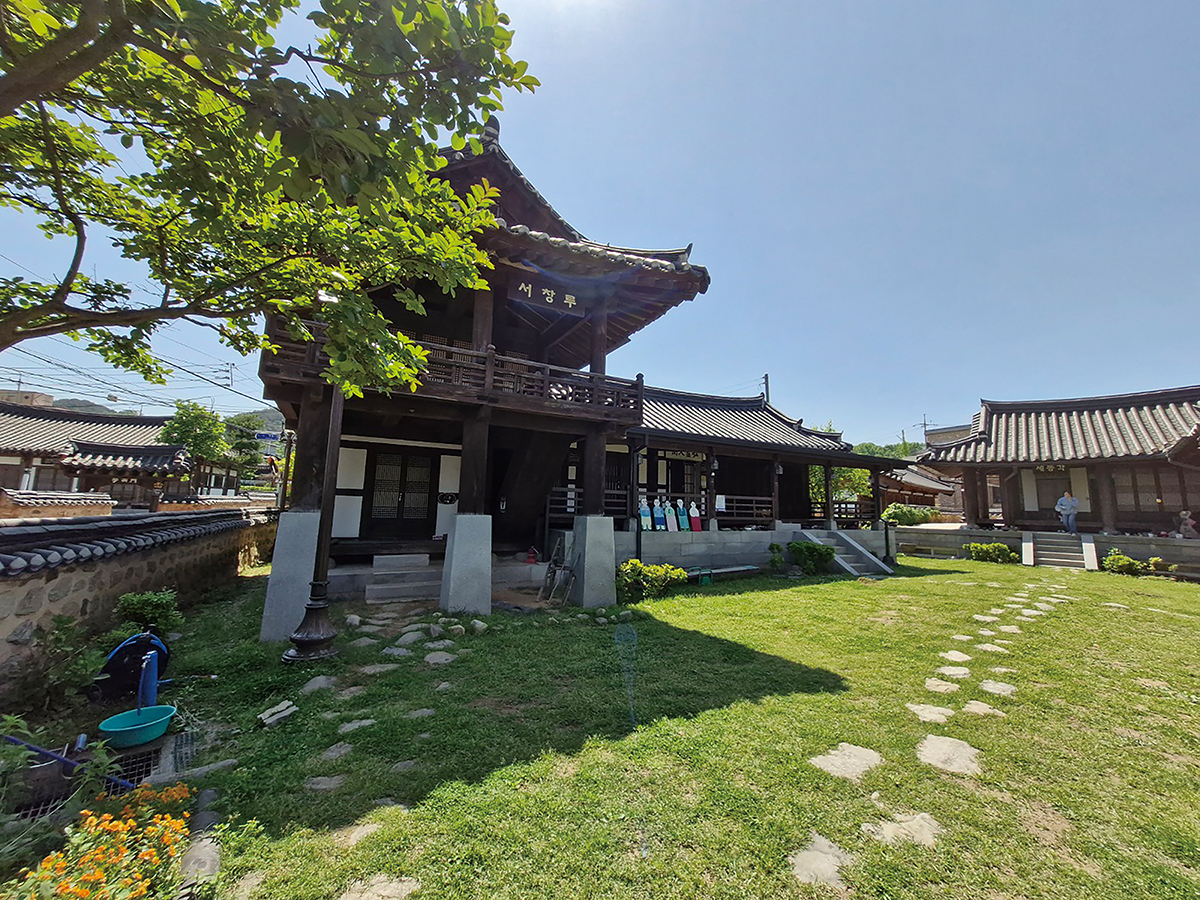Exploring Gwangju’s Village Heritage
The Seochang Hanok Culture Center
By Chung Hyunhwa
The Seochang Hanok Culture Center (서창한옥문화관) is a great place to start from when you want to experience Korean traditional culture as it remains in Gwangju. The Center is located in Seo-gu, only ten minutes from Gwangju-Songjeong Station, and five minutes from the airport. There are even public buses that travel there. Seochang is the name of the area, meaning “west storage” because it was a temporary storage area for collected tax grains to be sent to Seoul during the Joseon Dynasty.
You can enter the Hanok Culture Center through the west gate named Gyeokmul-mun (격물문, The Gate of Insight). Inside the Center, there is a grassy lawn, and around it, there is a tall pavilion named Seochang-ru (서창루), where you can watch the famous Seochang sunset; two traditional hanok buildings that are being used for hanok stays and named after great people from the village; a small hanok used as a traditional crafts classroom; and a café, Masil (마실), meaning “visiting a neighbor.”
The four hanok stay rooms have traditional double sliding doors with wooden frames and covered with traditional paper. However, for the visitors’ convenience, each room has an indoor bathroom. Of course, there are no beds in the rooms; they are only equipped with Korean style mattresses and comforters as they should be. You can make a reservation by phone (062-373-1365) or on their website. The smaller rooms for two or three people are between 40,000 and 60,000 KRW a night, and the bigger ones for six to ten people are between 80,000 and 100,000 KRW a night. I thought the prices were reasonable. The website is in Korean only, but the staff are extremely friendly and helpful. This place is run by the YMCA and supported by the Seo-gu District Office. The café is run by the village co-op (09:00–18:00, closed Mondays).
The crafts classroom is run for the visitors, and the young guests really enjoyed making bracelets and origami. The café is small, but it serves traditional home-made drinks as well as coffees. Through the wooden window frames, the hanok outside make a great scene. In the central yard, there are Korean games to play, such as tuho (투호, arrow throwing), guleong-soe (굴렁쇠, hoop rolling), and neol-ttuigi (널뛰기, seesaw jumping). You can also make a reservation to hold an event or a big party there. Prices vary according to space and time requirements.
Refurbishing of this village began around 1998. In 2004, the Traditional Hanok Experience Center opened, and in 2015, the village residents voluntarily sought funding from the government to preserve the traditional heritage there and share it with the public. The current Seochang Hanok Cultural Center was born through this effort.
If you walk out the north gate and turn right, you will find an annex building named Seha-dang (세하당), which is used for events and classes. Various regular programs are running there, and quite a variety of traditional hanbok costumes are kept for visitors to try on.
When I visited again for more pictures, the manager, Kim Hyeonsuk, said that a two-day culture experience program for expats is being planned for the first time for the end of June this year. This sounded like a fantastic opportunity to stay a night at a hanok and experience very authentic Korean culture. It will include a guided tour of the two villages there to find more hanok buildings and follow the traces of the great people in the history of the village, such as General Kim Segeun (김세근), who predicted the Japanese Invasion, the Imjin-waeran (임진왜란) in the 16th century. No one believed him, so he came down to the Gwangju area to gather and train hundreds of civilian soldiers on his own. He fought and died in a battle during the invasion. Another great figure is Yaeun, Kim Yonghun (야은 김용훈), a 19th-century descendant of General Kim, who passed the exam to work for the central government but decided to stay in his hometown to contribute to the education of the young people. There is a heroine, too, named Kim, also a descendant of the General, who avenged the murder of her husband. This tour will include the Yaeun-dang hanok and the beautiful Mangwi-jeong pavilion garden in the village as well. Some fun cultural activities, such as rice cake-making, mulberry harvesting, and hanbok costume try-ons will be added.
The Seochang Hanok Culture Center is an excellent starting point of exploration of nearby villages that have such a rich cultural and historical heritage. The more I learned, the more respectful I became towards the entire village, especially because of the great people who chose harder paths in life to keep their values and the village people who collaborated to preserve the spirit of their village. Visiting the Seochang Hanok Culture Center will certainly charge you with courage and peace.
The Author
Chung Hyunhwa is from Gwangju and currently working for a horticultural company. She led Gwangju Hikers, an international eco-hike group at the GIC in 2020 and 2021. Previously, she taught English in different settings, including Yantai American School and Yantai Korean School in China, and has worked for the Jeju school administration at Branksome Hall Asia in recent years. She holds a master’s degree in TESOL from TCNJ in the U.S, and a license to teach the Korean language. She loves plants, birds, and making useful items out of things that have lost their original purpose.




